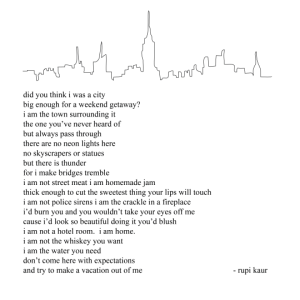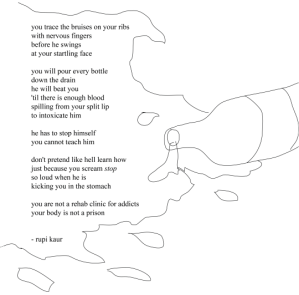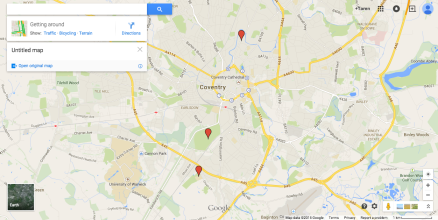Over the course of a few weeks we delved into the topic of ‘Here And There’.
‘I am from there. I am from here.I am not there and I am not here.I have two names, which meet and part,and I have two languages.I forget which of them I dream in.’
Mahmoud Darwish
We began by thinking about our own personal ‘here’ and ‘there’, discussing as a group what each place means to us. It was interesting to hear other peoples stories and see what other peoples perception of places are. To begin exploring this topic we were asked to create a set of phrases about our places. I decided my ‘here’ was Coventry, and that my ‘there’ would be India, as although I have only been twice so far in my life, I feel a strong connection to the place. Along with creating the phrases, we later were asked to mix and match the words up, creating an experimental approach to the phrases.
HERE
Cold, Grey, Rainy, Dull. – grey cold rainy dull, dull rainy grey cold, grey dull rainy cold, rainy dull cold grey, rainy grey cold dull, grey rainy dull cold, dull cold grey rainy.
This is where my family are. – is this where my family are, are my family is this where, my family are where this is, family is where this are my, where are my family this is, my this is family where are, this my are family where is.
I grew up here, there’s a lot of memories – i up grew theres here lot a of memories, lot of there’s grew memories i here up, a memories of grew i of here lot up theres, grew lot a here memories i lot of theres, here i grew memories there lot of a i, a i of lot there here memories grew.
It can seem quite boring here to me – seem boring quite me to here can it, here boring can it seem to me quite, boring me seem it can here, to seem boring it can quite here me, can it seem boring to me here quite, quite it boring me to here seem can, me to quite can seem it boring.
At the end of the day, it’s Home. – home its end of the day at the, end home the day at the of its, the at home its end day of the, day home its end the of the at day, the of the home end day at its, of its end home at the day the.
THERE
It feels like my Home away from Home. – home home its away feels it my like from, my away home like home feels it from, away from my home it feels home like, from home away home like feels it my, feels it like away home home from my, from home away it feels home like my.
Life there is completely different – is life there different completely, there is life completely different, life different completely there is, completely life there is different, there is different life completely, life is different completely there, completely there life different is, different completely there is life, is different life there completely, different is life completely there, completely life different there is, life different is there completely.
Constant noise, horns, animals, people, talking, shouting – horns constant animals noise people shouting talking, animals talking shouting horns noise constant, people horns constant animals shouting noise talking, horns animals shouting constant talking noise people, shouting constant people animals horns noise talking.
It can be vibrant and buzzing or beautifully calm and peaceful. – vibrant and peaceful or it be buzzing can calm and or beautifully, can it be beautifully buzzing or peaceful and vibrant and calm, and it calm be can it peaceful vibrant buzzing and or, be can buzzing beautifully vibrant and it and or calm, and peaceful it can be beautifully calm or vibrant and buzzing.
I love it, I love the people, the smells, the scenes, the food, the experiences, and the memories. – the smells i love the food and it experiences scenes and i love memories the people, memories the smells and i love experiences it food the love scenes the people , it love scenes the smells and love the I memories the people experiences love i the food.
I had a few ideas for creating a response to the theme, one of which could incorporate the Isadora software we learned about in class. I wanted to incorporate both worlds in some way, presenting how I miss India or how that is what I think about regularly. I thought about how when using the Isadora Software I could try to create almost a mini virtual world of some sort, where once a person is stepping on sensor or past a sensor, an image could be projected or shown somehow, of a life size person perhaps. I wanted to bring elements of each world together maybe, or take people into my world in India. This was a possibility or a starting point if I was able to successfully use Isadora for a big project.
Another idea I had was along the ideas of the Maps, which we had also discussed in class. I considered how I could use maps and satellites on a larger scale, and thought of holographic images of portraits I had taken popping up in my video, as if I was hallucinating them there. It feels to me like this longing to be there, and I wanted to perhaps show memories falling through the cracks of my mind into reality which end up playing through here in real life. Unfortunately I was not able to successfully undertake this idea as I did not have the correct knowledge to create such a video in a short space of time.
However, I did take along the idea of my own point of view walking, but not via satellite. I decided to shoot my own video as I was walking, to bring it more into my reality in Coventry. I had the idea of taking the audio from a video I took in Punjab, India, where I was doing a similar thing, sitting on the back of a scooter travelling through the streets and alleys of Amritsar. I wanted to bring all of the sounds from my journey and juxtapose them with the images of Coventry. I walked through the City Centre of Coventry and videoed my walk. In the editing process, I decided to change the colours and make the video black and white, to reflect my distaste to Coventry in comparison to India. I also slowed the video down and reversed my journey, to reflect how much I miss India and give a feeling of displacement.
Here is my short experimental video response I created for the theme of ‘Here And There’




